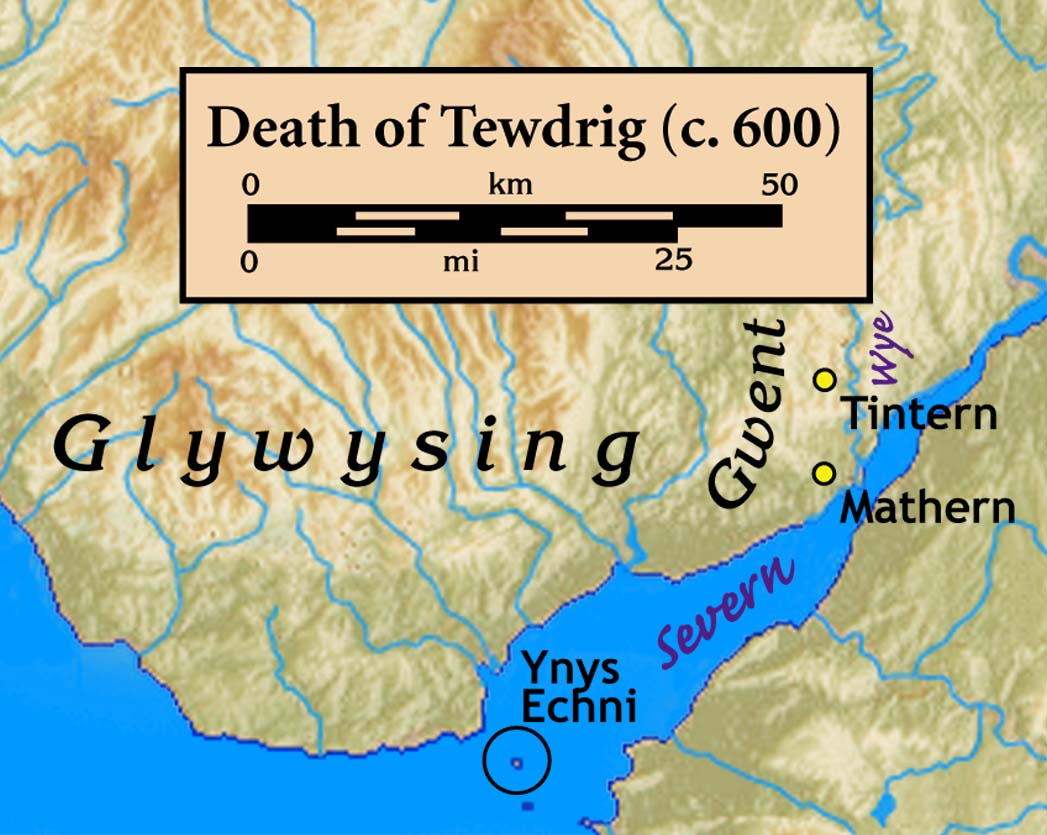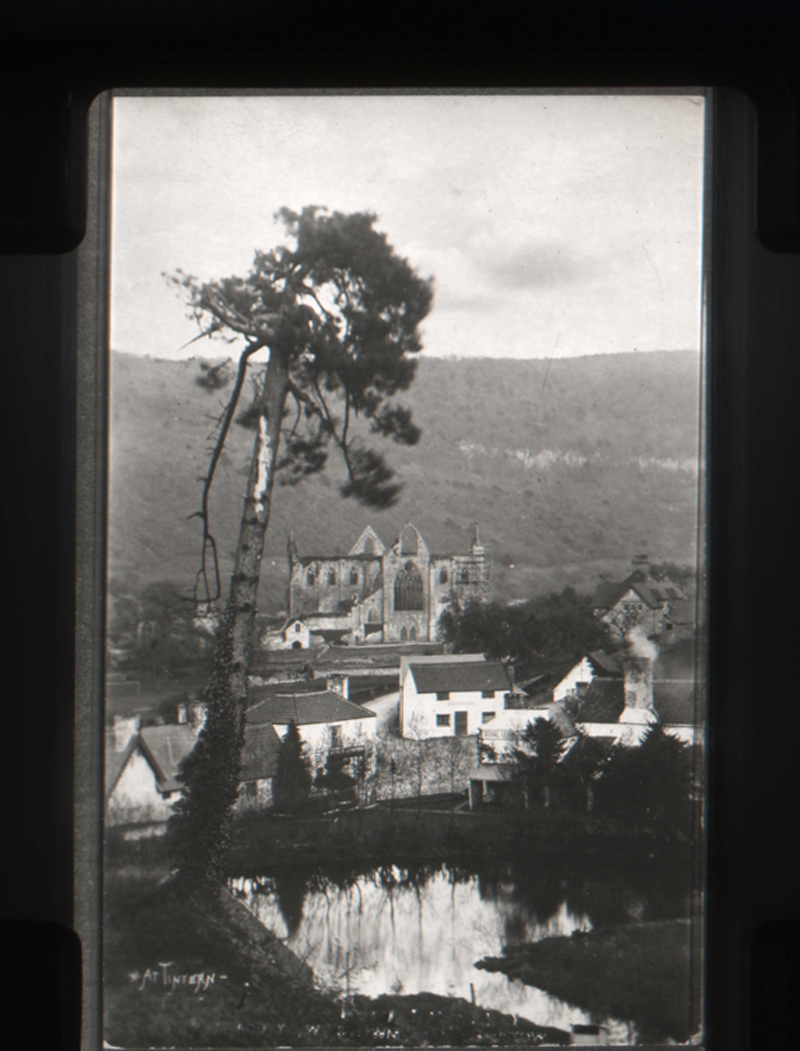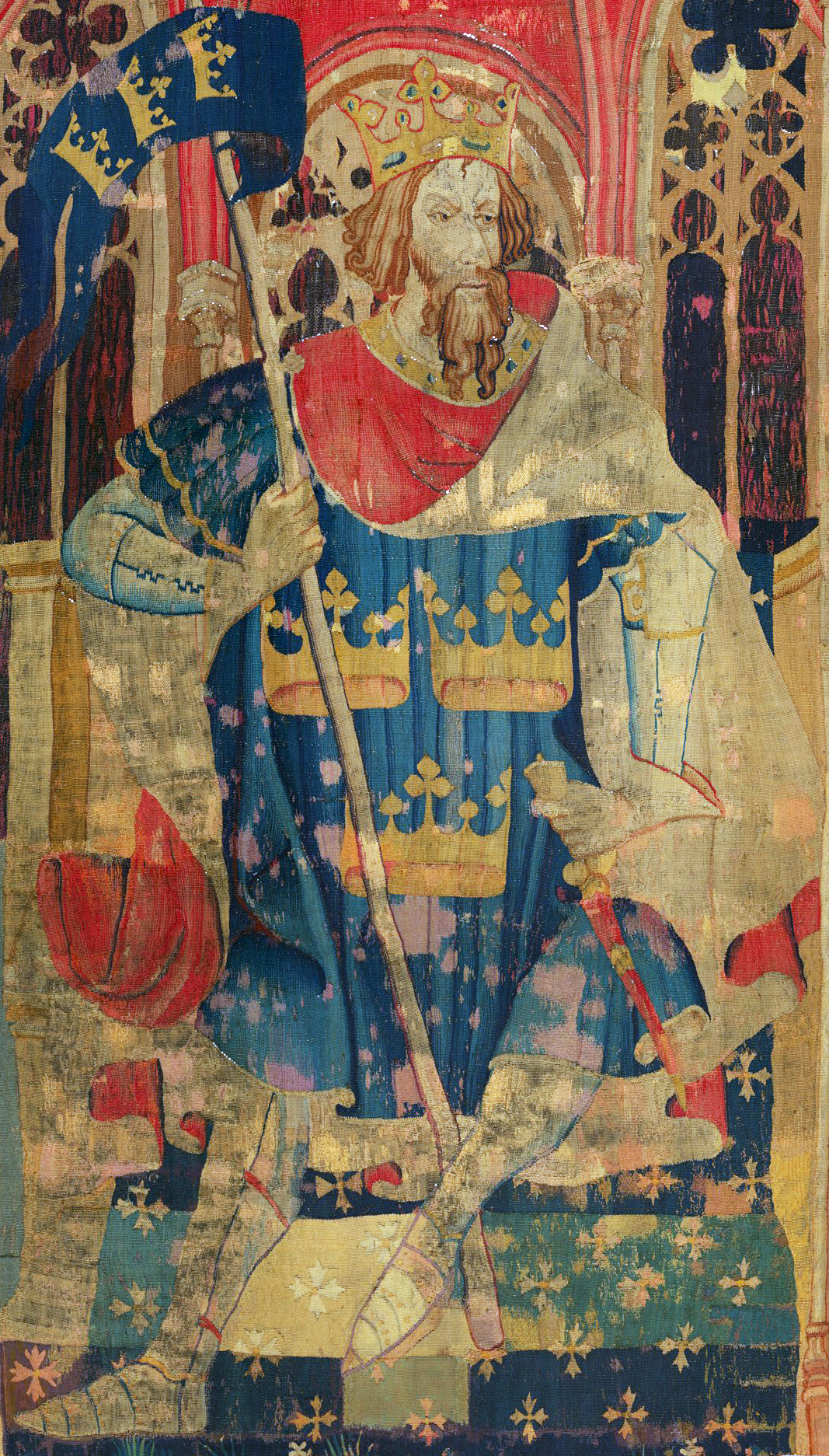|
Meurig Ap Tewdrig
Meurig ap Tewdrig (Latin: ''Mauricius''; English: ''Maurice'') was the son of Tewdrig (St. Tewdric), and a King of the early Welsh Kingdoms of Gwent and Glywysing. He is thought to have lived between 400AD and 600AD, but some sources give more specific dates of c.596 - c.665. Meurig took over the Gwent throne upon his father's abdication in the early 7th century. According to tradition, Tewdric became a hermit at Tintern, but later came to the assistance of Meurig, and they repelled the invading Saxons in a battle at Pont y Saeson (Bridge of the Saxons). Meurig reunited his kingdom with Ergyng (Archenfield) by marrying Onbrawst, the daughter of King Gwrgan Fawr (the Great) of that kingdom. He is said to have been a great patron of Llandaff Cathedral where he was eventually buried. He was the father of Athrwys ap Meurig who, it has been postulated, was the real King Arthur who drove out the invading Saxons. Some researchers claim that Meurig used the title "Uther Pendragon", wh ... [...More Info...] [...Related Items...] OR: [Wikipedia] [Google] [Baidu] |
Tewdrig
Tewdrig ap Teithfallt (; ), known simply as Tewdrig, was a king of the Sub-Roman Britain, post-Roman Glywysing, Kingdom of Glywysing. He abdicated in favour of his son Meurig ap Tewdrig, Meurig (Maurice) and retired to live a hermitical life, but was recalled to lead his son's army against an intruding Anglo-Saxons, Saxon force. He won the battle, but was mortally wounded. The context of the battle is one of Britons (historic), Britons versus Anglo-Saxon invasion of Britain, invading Saxons, without explicit religious overtones. Since Tewdrig held to a religious lifestyle and was killed while defending a Christians, Christian kingdom against Anglo-Saxon paganism, pagans, by the standards of that day Tewdrig is considered to be a martyr and a saint. The Latin form of his name is given as 'Theodoric' and his feast day is 1 April. Tewdrig's name appears in a Genealogies from Jesus College MS 20, genealogy of Jesus College MS 20, in the line of one of his descendants, but the only ... [...More Info...] [...Related Items...] OR: [Wikipedia] [Google] [Baidu] |
King
King is a royal title given to a male monarch. A king is an Absolute monarchy, absolute monarch if he holds unrestricted Government, governmental power or exercises full sovereignty over a nation. Conversely, he is a Constitutional monarchy, constitutional monarch if his power is restrained by fixed laws. Kings are Hereditary monarchy, hereditary monarchs when they inherit power by birthright and Elective monarchy, elective monarchs when chosen to ascend the throne. *In the context of prehistory, antiquity and contemporary indigenous peoples, the title may refer to tribal kingship. Germanic kingship is cognate with Indo-European languages, Indo-European traditions of tribal rulership (cf. Indic ''rājan'', Gothic ''reiks'', and Old Irish ''rí'', etc.). *In the context of classical antiquity, king may translate in Latin as ''rex (king), rex'' and in Greek as ''archon'' or ''basileus''. *In classical European feudalism, the title of ''king'' as the ruler of a ''kingdom'' is und ... [...More Info...] [...Related Items...] OR: [Wikipedia] [Google] [Baidu] |
Kingdom Of Gwent
Gwent () was a medieval Welsh kingdom, lying between the Rivers Wye and Usk. It existed from the end of Roman rule in Britain in about the 5th century until the Norman invasion of Wales in the 11th century. Along with its neighbour Glywysing, it seems to have had a great deal of cultural continuity with the earlier Silures, Miranda Aldhouse-Green &al. ''Gwent In Prehistory and Early History: The Gwent County History'', Vol.1. 2004. . keeping their own courts and diocese separate from the rest of Wales until their conquest by Gruffydd ap Llywelyn. Although it recovered its independence after his death in 1063, Gwent was the first of the Welsh kingdoms to be overrun following the Norman conquest. History Establishment The area has been occupied since the Paleolithic, with Mesolithic finds at Goldcliff and evidence of growing activity throughout the Bronze and Iron Age. Gwent came into being after the Romans had left Britain, and was a successor state drawing on the cultur ... [...More Info...] [...Related Items...] OR: [Wikipedia] [Google] [Baidu] |
Glywysing
Glywysing was, from the sub-Roman period to the Early Middle Ages, a petty kingdom in south-east Wales. Its people were descended from the Iron Age tribe of the Silures, and frequently in union with Gwent, merging to form Morgannwg. Name and early history Glywysing is said in medieval Welsh tradition to be named after Glywys, supposedly an early king of the region. In reality, the name probably comes from '' Glevum'', the Roman name for what is now Gloucester, via a Latin name *''Glevenses'' ('people of Glevum') or *''Glevensis'' ('person from Glevum'). Thus the name suggests that the kingdom was named after invaders or migrants, or a particular ruler, from Glevum. According to 12th-century sources, after the death of Glywys, the kingdom was divided into three cantrefs named for his sons: Penychen, Gwynllwg, and Gorfynydd. These were typically ruled together by the head of the family and sometimes treated as appenage subkingdoms. Location The borders changed over ... [...More Info...] [...Related Items...] OR: [Wikipedia] [Google] [Baidu] |
Tintern
Tintern () is a village in the community (Wales), community of Wye Valley (community), Wye Valley, on the west bank of the River Wye in Monmouthshire, Wales, close to the border with England, about north of Chepstow. It is popular with tourists, in particular for the scenery and the ruined Tintern Abbey. Modern Tintern has been formed by the coalescence of two historic villages: Tintern Parva, forming the northern end of the village, and Chapel Hill, which forms the southern end. The village is designated as a Conservation Area (United Kingdom), Conservation Area. In 2022 the community was renamed from "Tintern" to "Wye Valley" and had boundary changes. History Early history The name Tintern may derive from the Welsh ''din'' + ''d/teyrn'', meaning "rocks of the king".E. T. Davies, ''A History of the Parish of Mathern'', 1990 A Ford (crossing), ford, known as Tintern Ford, stretched across the tidal River Wye and was in use in Roman times. After the Romans withdrew from Wales ... [...More Info...] [...Related Items...] OR: [Wikipedia] [Google] [Baidu] |
Saxons
The Saxons, sometimes called the Old Saxons or Continental Saxons, were a Germanic people of early medieval "Old" Saxony () which became a Carolingian " stem duchy" in 804, in what is now northern Germany. Many of their neighbours were, like them, speakers of West Germanic dialects, including the inland Franks and Thuringians to the south, and the coastal Frisians and Angles to the north who were among the peoples who were originally referred to as "Saxons" in the context of early raiding and settlements in Roman Britain and Gaul. To their east were Obotrites and other Slavic-speaking peoples. The political history of these continental Saxons is unclear until the 8th century and the conflict between their semi-legendary hero Widukind and the Frankish emperor Charlemagne. They do not appear to have been politically united until the generations leading up to that conflict, and before then they were reportedly ruled by regional "satraps". Previous Frankish rulers of Austrasia ... [...More Info...] [...Related Items...] OR: [Wikipedia] [Google] [Baidu] |
Ergyng
Ergyng (or Erging) was a Brittonic kingdom of the sub-Roman and early medieval period, between the 5th and 7th centuries. It was later referred to by the English as ''Archenfield''. Location The kingdom lay mostly in what is now western Herefordshire (now in England), its heartland between the River Monnow and River Wye. However, it also spread into modern Monmouthshire and east of the Wye, where sits the old Roman town of '' Ariconium'' (Welsh: ''Ergyng'') at Weston under Penyard from which its name may derive; it may have been the first capital. Some maps show Ergyng extending across what is now the Forest of Dean to the River Severn. Monarchy After the withdrawal of the Roman legions from Britain in 410 AD, new smaller political entities took the place of the centralised structure. The area was originally part of the Kingdom of Glywysing (modern Glamorgan) and the Kingdom of Gwent, but seems to have become independent for a period under Peibio Clafrog in the 5th or 6th c ... [...More Info...] [...Related Items...] OR: [Wikipedia] [Google] [Baidu] |
Gwrgan Fawr
Gwrgan Fawr (meaning ''Gwrgan the Great''; also, in Latin language, Latin, Gurgantius; English language, English Fergus; died c. 645) was a king of Ergyng, a South Wales, south-east Welsh kingdom of the Early Middle Ages. He was the son of Cynfyn and rightful heir to the Ergyng throne which, however, was initially usurped by Gwrfoddw around AD 615. Gwrgan probably fled Ergyng when his inheritance was seized by Gwrfoddw Hen. He appears in four charters in the Book of Llandaff during the episcopate of Bishops Euddogwy and Inabwy. Later, Gwrgan features as king in charters in the Book of Llandaff associated with Bishops Oudoceus and Iunapeius. Gwrgan is referred to as King of Dumnonia, Damnonia by William of Malmesbury, who reports the terms of a grant of land made by him to the "old church" at Glastonbury in AD 601 in the time of Abbot Worgret.Edward Huttom, London, 1919, ''Highways and Byways of Somerset'', p.156. Little else is known of this monarch, despite his epithet "the Gr ... [...More Info...] [...Related Items...] OR: [Wikipedia] [Google] [Baidu] |
Llandaff Cathedral
Llandaff Cathedral () is a Church in Wales cathedral and parish church in Llandaff, Cardiff, Wales. It is the seat of the Bishop of Llandaff, head of the Church in Wales Diocese of Llandaff. It is dedicated to Saint Peter and Saint Paul, and three Welsh saints: Dubricius (), Teilo and Oudoceus (). It is one of two cathedrals in Cardiff, the other being the Roman Catholic Cardiff Metropolitan Cathedral in the city centre. The current building was constructed in the 12th century on the site of an earlier church. Severe damage was done to the church in 1400 during the rebellion of Owain Glyndŵr, during the English Civil War when it was overrun by Parliamentarian troops, and during the Great Storm of 1703. By 1717, the damage to the cathedral was so extensive that the church seriously considered the removal of the see. Following further storms in the early 1720s, work was begun in 1734 on a new cathedral designed by John Wood, the Elder, but this was never completed, and inste ... [...More Info...] [...Related Items...] OR: [Wikipedia] [Google] [Baidu] |
Athrwys Ap Meurig
Athrwys ap Meurig (c. 605–655) was a prince, and possibly king, of Gwent and Glywysing in Wales. He was the son of King Meurig ap Tewdrig and the father of the later king Morgan ab Athrwys. It is possible he died before his father Meurig and did not live to rule as king himself. History Athrwys's name is spelled variously. It is spelled ''Atroys'' (where -t- stands for the sound /th/) in the 10th century Welsh Harleian genealogies and ''Athruis'' in the early medieval Latin ''Liber Landavensis''. The name is etymologically related to that of the figure ''Andres s' (where -d- once again stands for the sound /th/) son of ''Morcant s' who appears in the early medieval Latin ''Life of St Cadoc'', concluding that both names derive from an Archaic Welsh spelling ''*Antrēs''. He was the son of Meurig ap Tewdrig, a King of Gwent and Glywysing in South Wales.Bartrum, p. 35. His mother was Onbrawst, daughter of Gwrgan Fawr, King of Ergyng. His siblings were Idnerth and Ffriog.Bar ... [...More Info...] [...Related Items...] OR: [Wikipedia] [Google] [Baidu] |
King Arthur
According to legends, King Arthur (; ; ; ) was a king of Great Britain, Britain. He is a folk hero and a central figure in the medieval literary tradition known as the Matter of Britain. In Wales, Welsh sources, Arthur is portrayed as a leader of the Sub-Roman Britain, post-Roman Britons in battles against the Anglo-Saxons in the late-5th and early-6th centuries. He first appears in two early medieval historical sources, the ''Annales Cambriae'' and the ''Historia Brittonum'', but these date to 300 years after he is supposed to have lived, and most historians who study the period Historicity of King Arthur, do not consider him a historical figure.Tom Shippey, "So Much Smoke", ''review'' of , ''London Review of Books'', 40:24:23 (20 December 2018) His name also occurs in early Welsh-language literature, Welsh poetic sources, such as ''Y Gododdin''. The character developed through Welsh mythology, appearing either as a great warrior defending Britain from human and supernatura ... [...More Info...] [...Related Items...] OR: [Wikipedia] [Google] [Baidu] |
Bernard Cornwell
Bernard Cornwell (born 23 February 1944) is an English author of historical novels and a history of the Waterloo Campaign. He is best known for his long-running series of novels about Napoleonic Wars rifleman Richard Sharpe. He has also written '' The Saxon Stories'', a series of thirteen novels about the unification of England. He has written historical novels primarily based on English history, in five series, and one series of contemporary thriller novels. A feature of his historical novels is an end note on how they match or differ from history, and what one might see at the modern sites of the events described. He wrote a nonfiction book on the battle of Waterloo, in addition to the fictional story of the famous battle in the Sharpe series. Three of the historical novel series have been adapted for television: the ''Sharpe'' television series by ITV, '' The Last Kingdom'' by BBC and '' The Winter King'' for MGM+. He lives in the US with his wife, alternating between Cap ... [...More Info...] [...Related Items...] OR: [Wikipedia] [Google] [Baidu] |





